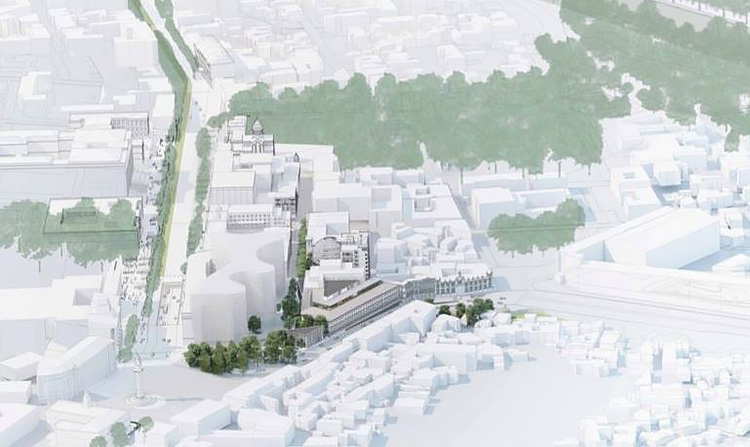Culture ministry denies rumours on plans to "demolish" crumbling Museum of Fine Arts

The Fine Arts Museum has received few efforts on improving its conditions in the recent years. Photo via Georgian National Museum.
The Ministry of Culture, Sport and Youth has denied media reports on a possibility of the long-neglected Shalva Amiranashvili Museum of Fine Arts, a major cultural venue in central Tbilisi, being demolished, after an opposition-minded TV channel and social media rumours indicated nefarious plans in place for removing the building.
The ministry's strongly-worded response on social media on Thursday rejected "false information" about the museum's fate, after a news piece on Mtavari Arkhi channel on Wednesday evening alleged the ministry had "decided" to demolish the venue.
In its reaction post the ministry said the allegations were attempts to "cover up grave conditions [of the building] caused by inaction" of culture officials during the former United National Movement government, alluding to links between the party - now in opposition - and the TV channel. The response also called social media reactions to the news story "fake indignation".
Releasing photographs showing the grave conditions for the venue's structural integrity, the ministry said the situation "reflects the circumstances" resulting from inaction of those "responsible for the cultural monument" during the UNM government between 2003-2012.

A look at the interior of the museum in its current state. Photo via Ministry of Culture, Sport and Youth.
The cultural agency also directly linked damage to a part of the building to the UNM-launched project for setting up a highway adjacent to the museum "in a way that resulted in a part of the venue falling over". The highway project was later finalised by the Georgian Dream government in 2015.
Responding to the allegations of the current ministry's plans for the museum, the post said the intentions involved "saving the unique exhibits of the museum and not demolishing the museum". The culture agency also mentioned highlights from an engineering study commissioned by it earlier this month to illustrate the building's current condition.
The major part of public controversy on social media came from the Mtavari Arkhi news piece focus on a part of the study where the company commissioned by the culture ministry says strengthening the side of the venue facing the adjacent Gudiashvili Street side "might not be commercially viable".

The building's exterior also bears signs of neglect and disintegrating damage. Photo via Ministry of Culture, Sport and Youth.
The TV outlet used the quote to allege it indicated plans to remove the museum, and linked the alleged plans with private interests involved in the highly controversial Panorama Tbilisi, a $500 million development project implemented by the Georgian Co-Investment Fund - established by businessman and former Georgian Dream government prime minister Bidzina Ivanishvili.
In an interview for the news report, Tbilisi historian Tsira Elisashvili told the opposition channel heavy construction work on an adjacent, expansive Panorama Tbilisi hotel - ongoing since the mid-2010s against opposition from some urbanists and a part of Tbilisi citizens - had caused a worsening of the museum building's structural integrity.
The Mtavari Arkhi report also quoted an MP from UNM alleging plans in place to demolish the museum "for the needs of Bidzina Ivanishvili and his project".
As recently as April, the Museum of Fine Arts - housing some of the major exhibits including early Medieval religious iconography and accessories, items of historical architecture and monumental painting - was the focus of an announcement by the culture ministry that said it planned to restore the venue.

The museum venue (highlighted) is found between Gudiashvili and Pushkin streets near Freedom Square in central Tbilisi. Image from Georgian National Museum plan for rehabilitating the museum.
The announcement followed a 2019 meeting between David Lordkipanidze - General Director of the Georgian National Museum network the Museum of Fine Arts is a part of - with architect Jean Francois Milou and Suzanne Ogge, Director of Heritage and International Projects at studioMilou, on "action plan for rehabilitating" the museum.
This year, the GNM also published its plan for the rehabilitation as a phased initiative scheduled between 2021-2024, starting with a study of the state of the building and a temporary removal of its precious exhibits to nearby GNM venues starting this year, and ending with a conclusion of the rehabilitation of the building three years later.
Commissioned by Iakob Zubalashvili of a notable 19th century Tbilisi family of entrepreneurs and philanthropists, the building opened in 1835 based on a project by Swiss architect Giuseppe Bernardacci.
Initially serving as a hotel, the venue was later used for a spiritual seminary beginning in 1840. Another hotel opened its doors in the building in 1921, before the Museum of Fine Arts - founded by Georgian painter and public figure Dimitri Shevardnadze - found its home within its walls starting in 1950.
 Tweet
Tweet  Share
Share